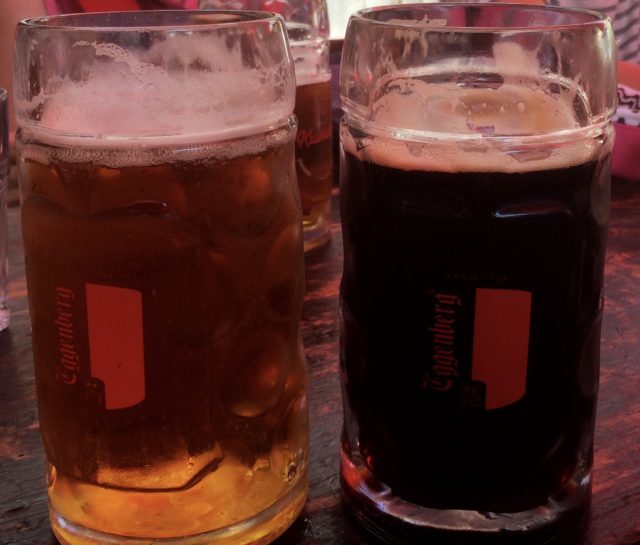
The beer world is replete with traditions: American IPA, English cask bitters, Belgian abbey ales… But none have the distinction, nor cast a longer shadow than, that of Czech lagers.
As the story goes, ’round about 1840, a citizens’ brewery in Pilsen, Bohemia, recruited a brewer from neighboring Bavaria, Josef Groll, to invent a premium beer they could hang their hat on. Groll accepted, brought Bavarian lager yeast across the border, combined it with the native Saaz (or Žatec) hops, Bohemia’s soft water, and pale malting techniques perfected in England. The result was a sparkling golden beer, crisp and clean, flavorful and tangy, with a refined taste and distinct balance. They called it Plzeňský Prazdroj, or, in German, pilsner urquell, “pilsner original source.”
It was a watershed moment in brewing and the majority of all beers produced since echo — no matter how faint — Groll’s Pilsner Urquell.
Though the ingredients of Czech lager are simple (pale/Pilsner malt, Saaz hops, lager yeast), the beauty lies in the brewing technique. The barley is floor-malted — less modified than other malts, thus richer and more flavorful — and works better with decoction mashing. This labor-intensive process involves drawing off portions of the mash, boiling it in a separate vessel and then returning it to the mash, raising the overall temperature. Time-consuming, to say the least, but it develops a level of malt character second to none.
Ditto for first wort hopping — which adds hops early in the process and takes the spike off the bitterness and smooths out rough characteristics — and long lagering times, all of which tend to be cost-prohibitive for small brewers. You could make a lager without them, but then it wouldn’t be the Czech lager.
Lucky for Boulder County drinkers, few brewers are as steeped in European brewing traditions as Brandon Boldt of 4 Noses Brewing Company, Primitive Beer and Wild Provisions Beer Project. And on July 18, Wild Provisions will celebrate its official grand opening with two new Czech-inspired lagers, on tap and in the can.
As Boldt explains, Wild Provisions sources all of its grains from the Czech Republic and uses reverse osmosis water blended with carbon filter municipal water to mimic Pilsen’s soft water. Mashes are decocted, and the wort is boiled for two hours with multiple Saaz additions. All of this takes place at 4 Noses’ brewhouse in Broomfield. Once the wort is ready, it’s trucked up to Wild Provisions fermentation room in Boulder, where it’s put through a heat exchanger, dropping the temperature before it’s released into a coolship, lowering the temperature even more. Unlike the Flemish koelchip (they’re pronounced the same way), Boldt uses this coolship to precipitate out insoluble proteins as a type of pre-fermentation filtration and clarification. It takes two hours. The wort is racked into an open fermentation vessel, which Boldt says allows the lager yeast to express its extra-cleanliness and scrubs the beer of any volatile compounds.
Fermentation takes about seven to 10 days. Then the beer matures in a horizontal lagering tank for another 30 to 40 days before it’s ready for consumption.
The results are a thing of beauty, and starting July 18, you can drink them at a cost substantially less than a plane ticket to the Czech Republic. Na zdraví.
Pale or dark?
Despite the ubiquity of Pilsner Urquell in liquor stores and bars, Czech lagers are difficult to come by unless you visit the source — the above photo of a světlý ležák (pronounced svet leh lay zhak) and a tmavé pivo (pronounced t’ ma veh PEE voh) was taken at the restaurant Zdroj in Český Krumlov.
Though there are a few variants as far as strength and color, most Czech lagers are either pale or dark. Wild Provisions follows suit with Premium Pale Lager (PPL) and Czech Dark Lager (CDL). Made entirely from floor-malted Pilsner malt and Saaz hops, PPL is triple decocted with three separate Saaz additions. CDL is primarily Pilsner malt but with floor-malted Bohemian Dark malt and CaraBohemian, with some dehusked Carafa Special 2 added during the sparge process. Boldt does this “to reduce pyrolytic flavor contributions but still darken the color and push aromas of bakers chocolate.”
Like the PPL, the CDL is boiled for two hours with three separate Saaz additions before the journey to the coolship, fermenter and maturation tanks.














